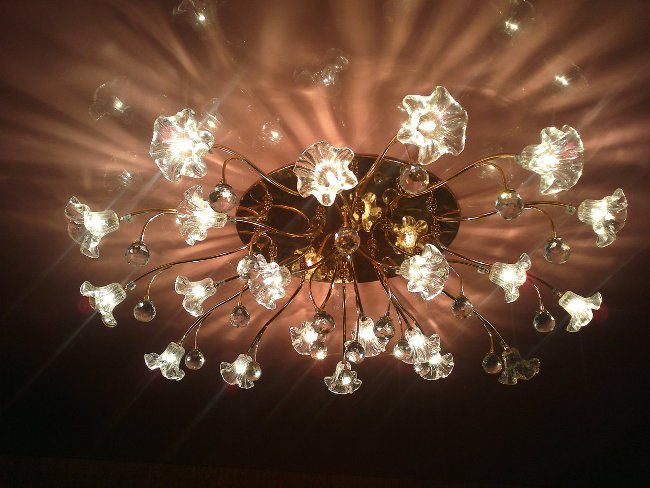Repair of the ceiling

With the onset of spring so want to enjoy the bright sun, warm wind. It's time to critically examine your home: is not it time to do repairs? Particular attention should be paid to repair of the ceiling.
What should be the ceiling? First of all - even. Plus, it should not threaten to be showered with small (and sometimes not so) pieces of plaster. The most common types of ceiling finish, such as painting and whitewash. These procedures are quite possible even for a professional and will cost less than the construction of tension or suspended ceilings.
Before painting or whitewashing the ceiling, certain preparatory work. First, clean the ceiling of the oldcoatings. After carefully inspecting the ceiling for various defects, it's time to start fixing them. If the ceiling has cracks, then they need to be expanded with a spatula and completely remove those parts of the plaster that do not hold well. After these sections of the ceiling must be primed with a primer for porous substrates.
Deep cracks in the ceiling it is best to seal with putty on cementbasis. After that, the ceiling is once again primed and leveled with the finishing putty. It is important to remember that one thick layer always keeps worse than a few thin ones. Therefore, if there is a need to apply a layer of putty thicker than a half to two millimeters, then it is better to apply it in several layers. Do not start the next layer until the previous one has dried out completely.
If there are large cracks or joints of concrete slabs on the ceiling, they are recommended to be glued with a serpent, in extreme cases, a bandage can be used.
For whitewashing the ceiling is usually used chalky or calcareous whitewash. Which one to choose depends only onwishes and possibilities of the owner of the apartment or house. However, it should be remembered that the ceiling, previously whitewashed with lime, can not be whitewashed with chalk whitewash, since in this case stains and stains will appear on the ceiling.
You can prepare chalk whitewash yourself. To do this, take 5 liters of warmedabout 40-50 ° C water and dissolve in it 30 g of joinery glue, as well as 3 kg of chalk. Another recipe for whitewashing looks like this. Take 3-4 liters of water, dissolve in it 2.3 kg of chalk, 90 g of carpentry glue, 60 g of laundry soap and 17 g of blue. The prepared composition is sufficient for whitewashing 10-12 m2 the ceiling.
If you plan to whitewash the ceiling with lime, then for composition preparation you need to dilute 2-3 kg of slaked lime in a smalladd 400-500 g of water-dyed dyes in advance, as well as 50-100 g of table salt or 150-200 g of alum-alkali alum. All components should be thoroughly mixed and gradually add water until the volume of the mixture is 10 liters. You can increase the durability of the whitewash by adding 50-100 g of common table salt to 10 liters of whitewash. Lime whitewash is applied to the slightly damp surface of the ceiling.
Ceiling whitewashing is carried out with the help of whiteners or pneumatic sprayers. And if there is a special nozzle on thepaint, a conventional household vacuum cleaner can be turned into a spray gun. When applying a whitewash with a brush, it is important to remember that the direction of movement of the brush is of great importance. The last layer of whitewash should be applied towards the light source, i. E. to the window, while the previous one is across. Then the marks from the brush will not be visible.
If the ceiling was selectedpaint, then you should pay attention to the paint. For painting the ceiling, water-borne paints (acrylic, silicate, latex, silicone) are most convenient and popular. The paint should be chosen taking into account the type of room in which repairs are carried out. For example, moisture-resistant paints are suitable for painting the ceiling in the bathroom, but they are quite expensive, so in ordinary rooms you can do with paints for dry rooms.
The paint should be applied with a brush, roller or spray gun on pre-primed with dilutedpaint the surface of the ceiling. In this case, all minor defects that were imperceptible on the unpainted ceiling will be visible. When all identified defects are plastered and ground, you can paint the ceiling with undiluted paint.
As well as when whitewashing the ceiling, when painting, too it is important to monitor the direction of the brush. The last layer of paint - towards the light,the previous one is across. In addition, the last layer of paint is recommended to be applied with a new roller (if the roller is to be used for painting) with a medium-length pile, the foam rollers for this do not work.
If a thick coat of paint is needed, this can be achieved by applying several layers, each of which must completely dry before applying the next one.
At the end of work with the ceiling, whether it is whitewashing or painting, can not be arrangedin a draft. It is necessary to shade the windows if direct sunlight penetrates into the room. It is not recommended to include heaters or other electrical appliances in order for the whitewash to dry faster.














